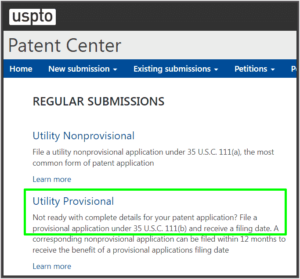 I wonder if this language on the USPTO’s Patentcenter web site is bad legal advice? The e-filing system asks “Not ready with complete details for your patent application?” And the answer the USPTO gives is that if you are “not ready with complete details” then what you should file is a provisional patent application.
I wonder if this language on the USPTO’s Patentcenter web site is bad legal advice? The e-filing system asks “Not ready with complete details for your patent application?” And the answer the USPTO gives is that if you are “not ready with complete details” then what you should file is a provisional patent application.
Let’s indeed suppose you are “not ready with complete details for your patent application.” I guess what this could mean is that you have not figured out what to say that would enable someone skilled in the art to practice your invention. Or maybe what it means is that you have not yet put words onto the page to disclose the best mode that you know of for practicing your invention.
Or maybe it is as simple as this — maybe it means that you have not yet figured out what your invention is. In other words, you are not yet actually in possession of it.
In any of these cases, you are “not ready with complete details for your patent application.”
If so, can you file a provisional patent application? Of course not! The mere fact that a patent application is a provisional patent application instead of a non-provisional patent application does not excuse the filer from the need to (for example) provide enablement and best mode in the patent application.
And yet the advice that the USPTO provides in Patentcenter is that the way to fix the problem of “not being ready with complete details for your patent application” is to change the application type from non-provisional to provisional. The tedious and old-fashioned business of actually coming up with “complete details” is a thing of the past, it seems. Just change the application type from “non-provisional” to “provisional” and you will have postponed for up to 12 months the need for that tedious and old-fashioned business of coming up with “complete details”, says the USPTO.
The alert reader will notice the “learn more” link a few lines down from this advice. Surely if you were to click to “learn more” from the USPTO about provisional patent applications, you would reach a new web page that, for example, mentions the need for the provisional patent application to contain best mode and enablement? Alas, even the “learn more” page (archived here) leaves these things unsaid. You can do a control-F on that page and you cannot find the words “best” or “enablement”.
I shudder to imagine how many fatally defective provisional patent applications have already been filed, and how many more fatally defective provisional patent applications will be filed, due to this advice given by the USPTO on the Patentcenter e-filing web page.

Maybe great advice if you remain in the “bubble” of the US patent system, but it sounds like a recipe for disaster to me if you decide that you want to file in other countries (particularly at the EPO) where they are particular about priority dates and the priority that is accorded to each piece of subject matter. Woe betide you if you file a later US application, try to use this as your priority application and you have not explicitly withdrawn your US provisional application “leaving no rights outstanding” before filing the later US application. The EPO at least will not be amused and even if they do not pick it up (for example you have filed via the PCT system and later entered the EP National Phase) this is certainly something that EP patent attorneys are always on the lookout for.
To be fair they said you can “file” as provisional. They never said it would be valid or even granted 🙂 /joking
Totally agree, Carl! Don’t file a napkin provisional (patent application)!
I always file a provisional application. The application receives a 21-year life-span instead of 20 years. This is very important for pharmaceutical patent applications.